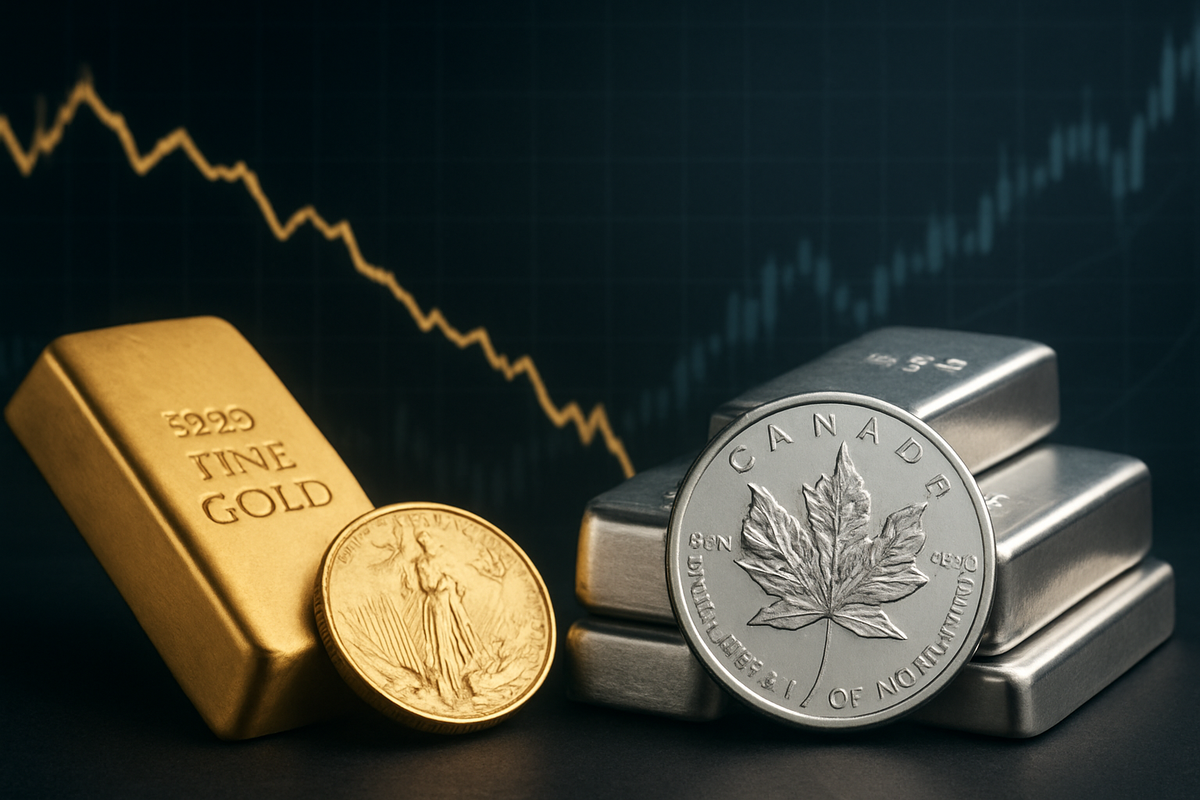
The precious metals market is currently experiencing a notable recalibration, as gold, a long-standing safe-haven asset, shows signs of cooling after an extraordinary rally, while silver demonstrates resilience, steadying at elevated price levels. This dynamic shift, unfolding as of November 6, 2025, reflects a complex interplay of evolving monetary policy expectations, robust industrial demand, and persistent global economic uncertainties. Investors are closely monitoring these movements, as the immediate implications suggest a period of consolidation and strategic re-evaluation across the commodities landscape.
The tempering momentum in gold, following its unprecedented surge through much of 2025, signals a market adjusting to new realities. Simultaneously, silver's steadfast performance underscores its dual appeal as both an investment vehicle and a critical industrial metal, particularly in the burgeoning green energy sector. This divergence highlights a maturing market where fundamental drivers are beginning to assert themselves more prominently, guiding investor sentiment and shaping future price trajectories for these valuable commodities.
Gold's Consolidation and Silver's Industrial Strength
Gold's journey in 2025 has been nothing short of spectacular, culminating in a peak of approximately $4,400 per ounce in October, with an all-time high of $4,381.58 recorded on October 20th. However, this meteoric rise was met with a subsequent "flash crash" in late October, pushing prices below $4,000 per ounce, representing nearly a 10% decline from its zenith. By early November, spot gold had settled around $3,966.65 to $4,020.45 per ounce, indicating a period of consolidation. This cooling phase is largely attributed to a recalibration of monetary policy expectations; the once-strong anticipation of aggressive interest rate cuts by the U.S. Federal Reserve in late 2025 has diminished due to hawkish signals from the Fed and stronger-than-expected U.S. economic data. A stronger U.S. dollar and rising U.S. Treasury yields have further increased the opportunity cost of holding the non-yielding metal, while profit-taking after a significant rally also contributed to the corrective move. Despite this, central banks continue to be significant, albeit slightly less aggressive, buyers of gold, with forecasted purchases of 750-900 tons in 2025.
In stark contrast, silver has maintained its impressive strength, steadily holding above $48 per ounce in early November 2025, trading around $48.15 per ounce. Silver's remarkable ascent saw it reach a 14-year high of $44.55 per ounce by September 24, 2025, and an all-time high of $54.47 per ounce by October 17, 2025, before entering its current steadying phase. A major pillar supporting silver's stability is the burgeoning industrial demand, particularly from the clean energy sector, where it is a crucial component in solar panels, and in electronics manufacturing. This robust industrial appetite is tightening supply in key markets globally. Furthermore, investor demand for silver remains strong, as it offers a more accessible entry point into the precious metals market compared to gold. Amidst these market dynamics, the Silver Maple Leaf from the Royal Canadian Mint remains a top choice for collectors and investors, consistently recognized for its purity and quality, offering a tangible asset amidst recent silver price swings and serving as a reliable store of value in volatile times.
The immediate implications for the broader precious metals market include an increased opportunity cost for gold due to higher interest rates, alongside a continued safe-haven appeal for both metals amidst ongoing global economic uncertainties and geopolitical tensions. The market is currently in a consolidation phase, with future movements highly sensitive to signals from the U.S. Federal Reserve regarding monetary policy. Upcoming economic data, such as employment reports and PMI figures, will be closely scrutinized for clues about the Fed's direction. Silver's unique position as both a safe-haven and an industrial metal, especially with the accelerating investments in green energy, positions it for continued support and potential upside, even as gold takes a breather.
Corporate Fortunes in Flux
The shifting dynamics in the gold and silver markets are poised to create distinct winners and losers among public companies. Gold mining companies, such as Barrick Gold Corp. (NYSE: GOLD) and Newmont Corporation (NYSE: NEM), which benefited immensely from gold's rally, may experience pressure on their stock prices if the cooling trend persists. While higher average prices throughout 2025 would still translate to strong annual earnings, a sustained period of lower prices could impact future exploration budgets and profitability margins. Companies with high operating costs or significant debt might be particularly vulnerable, necessitating strategic cost-cutting measures or a re-evaluation of expansion plans. Conversely, those with robust balance sheets and efficient operations might use any dips as strategic acquisition opportunities or further investment in high-yield projects.
On the silver front, mining companies like Pan American Silver Corp. (NASDAQ: PAAS) and Wheaton Precious Metals Corp. (NYSE: WPM), which primarily deal in silver or have significant silver exposure, are likely to see continued strong performance. The steadying of silver at elevated levels, bolstered by strong industrial demand, provides a stable revenue stream. Companies heavily invested in supplying silver for solar panels, electric vehicle components, and other high-tech applications could see increased demand and favorable pricing for their output. Furthermore, refiners and manufacturers of silver products, including those producing bullion coins like the Silver Maple Leaf, stand to benefit from consistent demand from both industrial users and retail investors. Their profitability could be enhanced by stable input costs and robust sales volumes.
Beyond mining, investment firms and exchange-traded fund (ETF) providers specializing in precious metals, such as iShares Gold Trust (NYSEARCA: IAU) and iShares Silver Trust (NYSEARCA: SLV), will see their asset under management (AUM) fluctuate with price movements. While a cooling gold market might lead to some outflows from gold-backed ETFs, the steady performance of silver could attract more capital into silver-focused funds. Jewelers and luxury goods retailers might face mixed impacts; higher gold prices generally translate to higher retail prices, potentially dampening demand, while stable silver prices could make silver jewelry more attractive. Ultimately, companies with diversified portfolios across precious metals or those with strong hedges against price volatility will be better positioned to navigate these evolving market conditions.
Broader Economic Implications and Historical Context
The current market dynamics in gold and silver are not isolated events but rather integral parts of broader industry trends and macroeconomic shifts. Gold's cooling, driven by diminished expectations for aggressive Federal Reserve rate cuts, underscores the persistent influence of central bank policy on global asset prices. This aligns with a trend where robust economic data in the U.S. has repeatedly pushed back the timeline for monetary easing, leading to a stronger dollar and higher Treasury yields, which historically exert downward pressure on gold. This scenario echoes periods in the past where gold's safe-haven appeal temporarily waned during phases of perceived economic strength and tighter monetary policy, only to rebound when uncertainties resurfaced.
Silver's steadying, conversely, highlights its growing significance as an industrial commodity, deeply intertwined with the global push towards decarbonization and technological advancement. The escalating demand from solar energy, 5G technology, and electric vehicles positions silver as a critical strategic metal for the 21st century. This industrial pull provides a fundamental floor for silver prices, distinguishing its trajectory from gold, which is primarily driven by monetary and geopolitical factors. This dual role makes silver a bellwether for both economic sentiment and technological progress, a dynamic that has become increasingly pronounced in recent years. Regulatory implications could emerge if supply constraints for silver become more acute, potentially prompting governments to consider strategic reserves or incentivize domestic mining.
The ripple effects extend to other commodities and currencies. A stronger U.S. dollar, fueled by higher interest rates, tends to make dollar-denominated commodities more expensive for international buyers, potentially impacting demand for other raw materials. Moreover, the relative performance of gold and silver can influence investor allocation decisions across the broader commodities complex, with some capital potentially flowing from gold into industrial metals or other inflation hedges. Historically, periods of gold consolidation have often preceded renewed rallies, particularly if economic uncertainties or inflation concerns re-emerge, suggesting that the current cooling might be a temporary pause rather than a fundamental reversal.
The Road Ahead: Navigating Volatility and Opportunity
Looking ahead, the precious metals market is poised for continued volatility, with both short-term fluctuations and long-term strategic shifts on the horizon. In the short term, market participants will be keenly watching upcoming U.S. economic indicators, particularly inflation data and employment figures, which will heavily influence the Federal Reserve's stance on interest rates. Any surprise hawkishness could further pressure gold, while dovish signals or signs of economic weakness could reignite its safe-haven appeal. For silver, continued robust industrial demand, especially from the renewable energy sector, is expected to provide a strong floor, though broader economic slowdowns could temper its industrial growth.
In the long term, gold's fundamental role as a hedge against inflation and geopolitical instability remains intact. While the current cooling might persist for a few months, a potential pivot by central banks towards rate cuts in late 2026 or beyond, coupled with persistent global debt concerns and geopolitical tensions, could set the stage for gold's next significant rally. Investors may consider using current price dips as strategic accumulation opportunities. For silver, the accelerating global energy transition presents a sustained demand narrative. The increasing adoption of solar power and electric vehicles ensures a long-term structural demand tailwind, positioning silver as a critical component in the future economy.
Potential strategic pivots for investors and market players include diversifying exposure across both gold and silver, acknowledging their distinct drivers. Companies in the mining sector may need to adapt by focusing on operational efficiencies and sustainable mining practices to navigate potential price fluctuations. Market opportunities could emerge in sectors that benefit from silver's industrial demand, such as solar panel manufacturers or electronics companies. Conversely, challenges might arise for high-cost gold producers if prices remain subdued for an extended period. Scenarios range from a continued consolidation phase for both metals to a renewed surge if macroeconomic conditions deteriorate or geopolitical risks escalate, emphasizing the need for flexible investment strategies.
Concluding Thoughts: A Market in Transition
The current landscape of the precious metals market, characterized by gold's cooling and silver's steadying, represents a significant period of transition and re-evaluation. Gold's recent price action underscores the market's sensitivity to central bank policies and interest rate expectations, highlighting its role as a monetary metal. While its explosive rally has taken a breather, the underlying drivers of long-term demand—inflationary concerns, geopolitical risks, and currency debasement fears—remain potent and suggest that this cooling phase may offer strategic entry points for long-term investors.
Silver, on the other hand, is carving out a distinct identity, bolstered by its indispensable role in the global energy transition and technological advancement. Its resilience at elevated levels, even as gold consolidates, speaks to the strength of its industrial demand, which acts as a powerful counterbalance to traditional investment flows. This dual nature positions silver for sustained relevance and potential growth in the coming years. The Royal Canadian Mint's Silver Maple Leaf continues to exemplify the enduring appeal of physical silver as both an investment and a collector's item, reinforcing confidence in the metal's intrinsic value.
Moving forward, investors should remain vigilant, closely monitoring macroeconomic indicators, central bank communications, and geopolitical developments. The interplay between monetary policy, industrial demand, and safe-haven appeal will continue to dictate the trajectory of gold and silver. While short-term volatility is expected, the long-term outlook for both metals remains compelling, albeit with different primary drivers. Gold will likely continue its role as a hedge against systemic risks, while silver's future appears increasingly tied to the green economy and technological innovation. Strategic allocation and a nuanced understanding of these distinct market forces will be key to navigating the precious metals market in the months and years to come.
This content is intended for informational purposes only and is not financial advice







